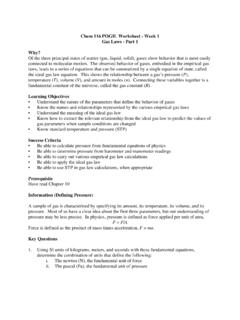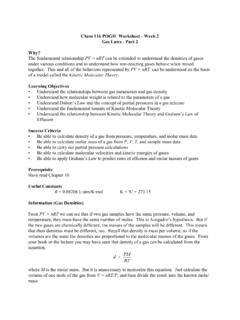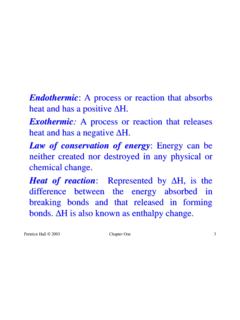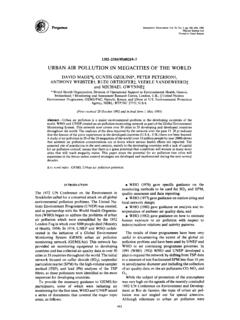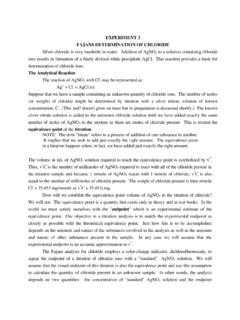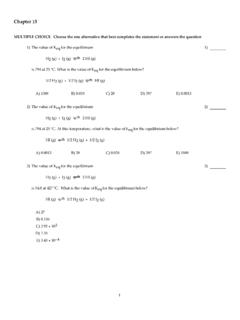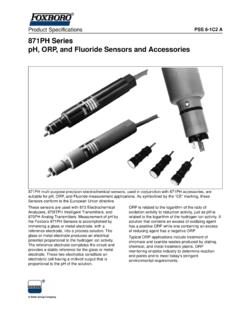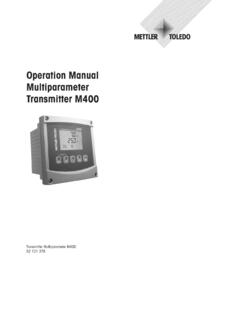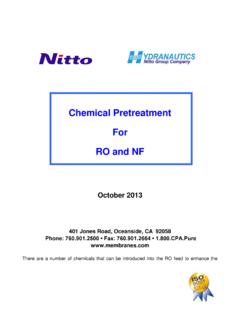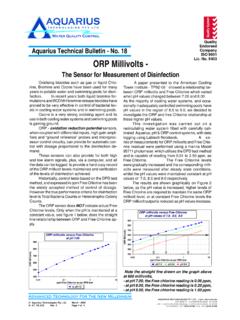Transcription of Lec 6 - Phosphine & Carbene Ligands
1 Tertiary phosphines, PR3, are an important class of Ligands because theirelectronic and steric properties can be altered in a systematicandpredictable wayover a very wide range by varying the R group(s).Tertiaryphosphinesalsostabilize anexceptionallywidevarietyofmetalPhosphi ne Ligands Tertiaryphosphinesalsostabilizeanexcepti onallywidevarietyofmetalcomplexesof interest to the organometallic chemist as their phosphinecomplexes (R3P)nM L. Phosphines are more commonlyspectatorrather than actor triphenylphosphine methyldiphenylphosphinePFFFPMeOOMeOMePPh OOPhOPhPCyCyCytrifluorophosphinetrimethy lphosphitetriphenylphosphitetricyclohexy lphosphinePMeMePMeMePMeMePPhPhPPhPhMe*di methylphosphinomethane(dmpm)dimethylphos phinoethane(dmpe)PROPHOSPPhPhPPhPhPPhPhP PhPhPPhPhPPhPhMe*dihlhhihdihlhhihMe*dime thylphosphinomethane(dmpm)dimethylphosph inoethane(dmpe)S,S-chiraphosCyPPhMePPhPh -4-OMePPh4-MeO-PhPh2P*PAMPDIPAMPPPh2*OOM eMe*DIOPPPRRRR**PPDuPHOSRRRR**2 The range and complexity of Phosphine Ligands has increaseddramatically inrecent years due to the development of C-X coupling reactions such asBuchwald-Hartwig Like NR3, phosphines have a lone pair on the central atom that can be donated to a metal.
2 Unlike NR3, they are also -acids, to an extent that depends on the nature of the R groups present on the PR3ligand. For alkyl phosphines, the acidity is weak; aryl, dialkylamino, and alkoxygroups are successively more effective in promoting acidity. In the extreme case of PF3, the acidity becomes as great as that found for CO!In the case of CO the * orbital accepts electrons from the metal. The *orbitals of the P R bonds play the role of acceptor in Whenever the R group becomes more electronegative, the orbital that the R fragment uses to bond to phosphorus becomes more stable (lower in energy). This implies that the *orbital of the P R bond also becomes more stable. At the same time, the phosphorus contribution to *orbital increases, and so the size of the *lobe that points toward the metal increases Both of these factors make the empty *more accessible for back donation. The final order of increasing -acid character isPMe3 P(NR2)3< PAr3< P(OMe)3< P(OAr)3< PCl3< PF3 CO 5 The empty P R *orbital plays the role of acceptor in metal complexes of PR3.
3 As the atom attached to the P atom becomes more electronegative, the empty P X *orbital becomes more stable (lower in energy) making it a better acceptor of electron density from the metal Occupation of the P R *orbital byback donation from the metal alsoimplies thatthe P R bonds shouldlengthen slightly on binding.*LnMLnM-PR3PR3 In practice, this ismasked by asimultaneous shortening of the P Rbonddue to donation of the P lonepair to the metal, and theconsequent decrease in P(lonepair) R(bonding pair) repulsions. Once again, as in the case of CO, theM L bond is made at the expenseof a bond in the ligand, but this timeit is a , not a , *PR3PR3 The electronic effect of various PR3ligands can be adjusted by changing the R group as, quantified by Tolman, who compared the (CO) frequencies of a series of complexes of the type LNi(CO)3, containing different Electronic ParameterCO stretching frequencies measuredfor Ni(CO)3L where L are PR3ligands of different -donor abilities.
4 [v(CO) =2143 cm-1]The increase in electron density at the nickel from PR3 -donationis dispersed through the M-L systemvia -backbonding. Much ofthe electrondensity is passed onto the CO * and is reflected indecreasedv(CO) stretching frequencies which corresponds toweaker CO Rev. 1977 (77) 3138 The second important feature of PR3as a ligand is thevariable steric size,which can be adjusted by changing R. CO is so small that as many can bind as are needed to achieve 18e. In contrast,the same is rarely true for phosphines, whereonly a certain number ofphosphines can fit around the metal. This can be a great advantage in that by using bulky PR3ligands, we can favorforming low-coordinate metals or we can leave room for smallbut weaklybinding Ligands ,Tolman Cone Angle The usual maximum number of phosphines that can bind to a single metal is two for PCy3or P(i-Pr)3 three or four for PPh3 four forPMe2Ph five or six for PMe39 Coordination Number(CN) the number of bonding groups at metal centre Low CN favored by:1.
5 Low oxidation state (e-rich) Large, bulky Pd(P(tBu)2Ph)2is coordinatively unsaturated electronically, the steric bulkunsaturated electronically, the steric bulkof both P(tBu)2Ph Ligands prevents additional Ligands from coordinating to the The cone angle is obtained by taking a space-filling model ofthe M(PR3) group,folding back the R substituents as far as they will go, and measuring the angle of thecone that will just contain all of the ligand, when the apex ofthe cone is at themetal. Although the procedure may look rather approximate, the angles obtained havebeen very successful in rationalizing the behavior of a widevariety of Tolman's cone angleTolman Plot of Electronic Parameter and Cone Angle12 An important part of organometallic chemistry consists in varying the steric and electronic nature of the ligand environment of a complex to promote whatever properties are desired: activity or selectivity in homogeneous catalysis, reversible binding of a ligand, facile decomposition, or high stability.
6 Using the Tolman plot we can relatively easily change electronic effects without changing steric effects , by moving from PBu3to P(OiPr)3 Also, we can relatively easily change steric effects without changing electronic effects , by moving from PMe3to P(o-tolyl)313 The concept of a double bond between transition metals and carbon constitutes one of the most important elements in the field of organometallic chemistry The notion of a metal carbon double bond was first brought forward by Fischer and Maasbol in 1964 with the synthesis of (CO)5W=C(Ph)(OMe) Soon after the discovery of Fischer type complexes their chemistry was systematically explored and they have been since well established as valuable species in organic synthesis as well as in catalytic processes Schrock later prepared a number of tantalum complexes including (Np)Ta=CH(CMe) and ( 5-Metal Carbenes Schrock later prepared a number of tantalum complexes including (Np)3Ta=CH(CMe3) and ( 5-Cp)2 MeTa= Fischer, A.)
7 Maasbol, Angew. Chem. 1964, 76, H. Dotz, Angew. Chem. Int. Ed. , 23, D. Wulff, Metal- Carbene Cycloadditions in Comprehensive Organic Synthesis , Wiley-Interscience:New York, S. Hegedus, Transition Metals in the Synthesis of Complex Organic Molecules , 1994, University Science R. Schrock, J. Amer. Chem. , 97, R. Schrock, Acc. Chem. , 12, Two different patterns of reactivity emerged during the development of these systems resulting in their classification as Fischer and Schrock type carbenes. Each represents a different formulation of the bonding of the CR2group to the metal and real cases fall somewhere between the type vs. Schrock type Carbene complexes15If we consider the Schrock Carbene as a Fischer Carbene with stronglyenhanced M C p-back bonding, the 2 electrons originally in M(d ) transferCOWCOOCOCCOOCH3CH3W(0) , 18 VETaCH3 HHTa(0) , 18 VE The more electropositive early transition metal complexes have less stable M(d ) orbitals, easier to oxidize.
8 For example d2metals are especially strong p-donors. The system can thus be visualized as a metal stabilized carbanion acting as both a and donor to the the C(pz) orbital, oxidizing the metal by 2 units and giving a Free Carbene CH2has two distinct spin isomers:singlet and triplet not resonance forms (sinlget triplet resonance forbidden) Singlet and triplet forms have different H-C-H angles In the singlet state 2e-are paired up in the sp2orbital leaving the pzorbital unoccupied In the triplet state both the sp2and p orbitals are singly In the Fischer (singlet) case, direct C M donation predominates and the carbon tends to be positively charged. In the Schrock (triplet) case, two covalent bonds are formed, each polarized toward the carbon giving it a negative Taylor and Hall used ab-initio calculations to differentiate between the electronic structures of Fischer and Schrock type Carbene complexes.
9 Calculations on a variety of free carbenes indicated that heteroatom and phenyl substituents preferentially stabilize a singlet ground state. alkyl and hydride substituents stabilized a triplet ground state at the Carbene carbon. Carbenes are both thermodynamically and kinetically unstable therefore forming very strong metal-carbenebonds disfavoring dissociationmetal-carbenebonds disfavoring just as paramagnetic triplet :CH2can dimerize to form diamagnetic H2C=CH2, it also binds to a triplet LnM fragment to give a diamagnetic LnM= E. Taylor, M. B. Hall, J. Amer. Chem. , 106, Carbynes Have similar bonding formulations as per Fischer and Schrock carbenes The free carbyne can be of doublet (Fischer) or quartet (Schrock) multiplicity The carbyne ligand is linear Carbyne carbon is sphybridized The M C bond is very short ( ) Characteristic low-field 13 CNMR resonance in the range +250 to +400 ppm20 Fischer Carbynes A doublet (Fischer) carbyne is sphybridized Contains one filled sporbital capable of donating 2e-to a metal centre Contains one singly occupied p orbital capable forming an additional bond The remaining empty porbital is capable of M C back donation 3e-donor covalent model (or 4e-donor ionic model)21 Schrock Carbynes A quartet (Schrock) carbyne is also sphybridized Contains three singly occupied orbitals (one spand two p) capable of forming three covalent M-C bonds (one s and two p bonds)
10 3e-ligand in covalent model (or6e-ionic model)22


